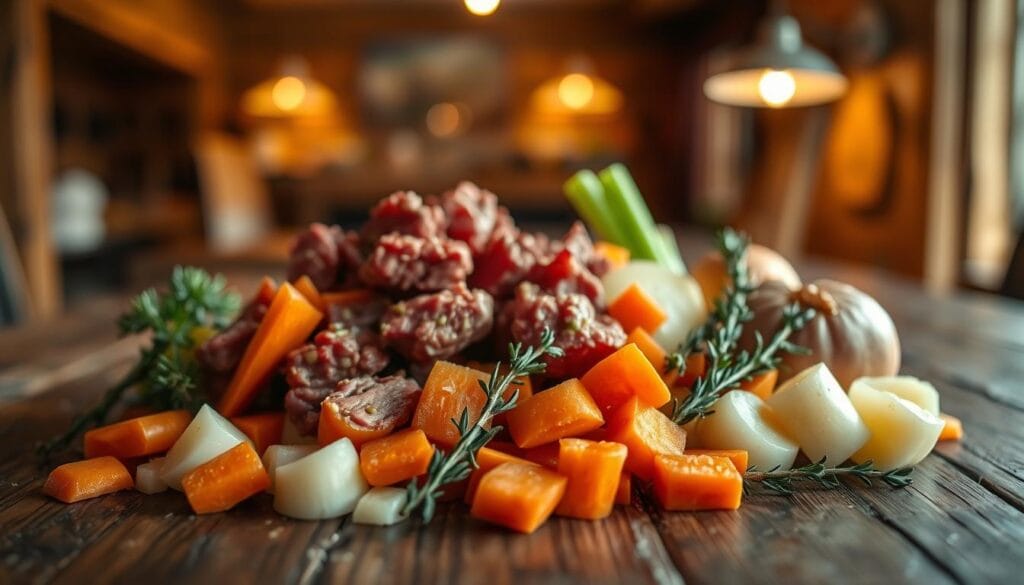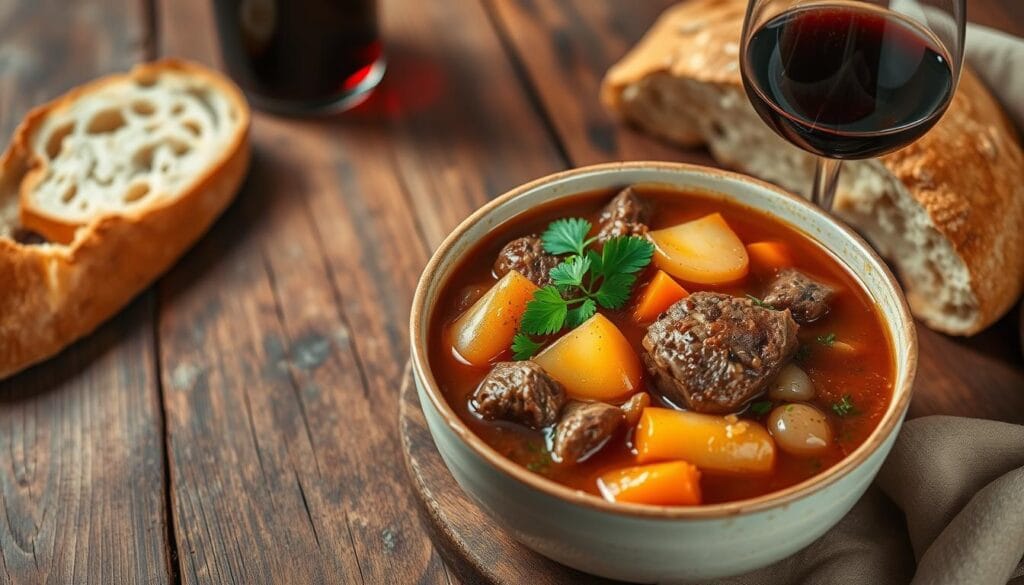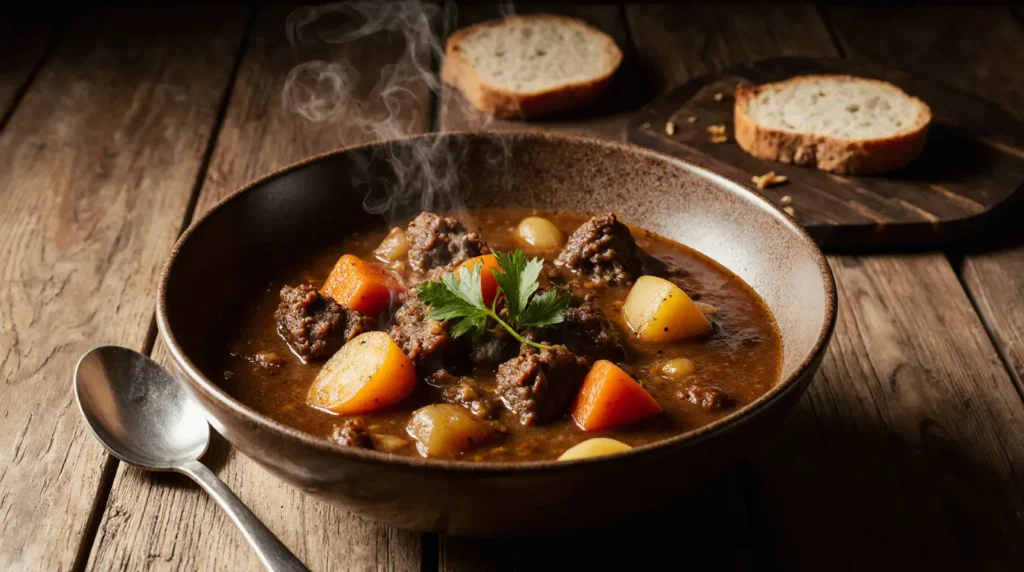When winter winds blow, nothing warms us like a slow simmer beef stewhttps://mysavorrecipes.com/dinner/. It’s more than a meal; it’s a hug in a bowl. It turns simple ingredients into a feast of flavors and memories.
Your kitchen will fill with delicious smells as you make a hearty beef stew. It’s not just cooking; it’s an art that makes tough meat tender and delicious.
This guide will show you how to make a comforting beef stew. Your family will love it and wait for more. We’ll cover choosing the right ingredients and the slow cooking process. You’ll learn to make a stew that’s a warm hug on a plate.
Ready to make slow simmer beef stew magic? Turn a simple dinner into a special moment. Your cooking journey begins here.
The Magic Behind Perfect Slow Simmer Beef Stew
Making the best beef stew is an art that needs patience and a grasp of slow cooking. It’s magic when tough meat turns tender and full of flavor through slow cooking.
Slow cooking is more than a method—it’s a way to transform your stew. It turns it from ordinary to amazing. The slow cooking breaks down meat, making it tender and adding deep flavors.
Understanding the Slow Cooking Process
Choosing to slow simmer your beef stew opens up a world of flavors. The process includes:
- Cooking at low temperatures (usually 180-200°F)
- Letting ingredients blend into complex flavors
- Making tough meat tender naturally
Benefits of Slow Simmering
Slow simmering brings many benefits to your beef stew:
- Enhanced Flavor Development: Ingredients blend perfectly
- Meat becomes very tender
- Less nutrient loss than high-heat cooking
Temperature Control Tips
Mastering temperature is key for your stew. Remember these tips:
- Keep the heat low and steady
- Use a reliable meat thermometer
- Don’t open the lid too often
By following these tips, you’ll make a stew that’s unforgettable.
Essential Ingredients for a Classic Beef Stew

Making a tasty homemade beef stew begins with picking the right ingredients. Your classic beef stew needs specific parts that blend to create rich flavors.
The key to a great stew is the meat. Choose chuck roast or beef shoulder for the best taste and tenderness. These cuts get soft and tender when slow-cooked, making the meat super tender.
- Protein Base:
- Chuck roast (2-3 pounds)
- Beef shoulder
- Cut into 1-inch cubes
- Vegetable Essentials:
- Yellow onions
- Carrots
- Celery
- Potatoes
- Flavor Enhancers:
- Beef broth
- Red wine
- Fresh thyme
- Bay leaves
Your homemade beef stew will stand out with fresh, strong ingredients. Fresh veggies add texture and flavor, while herbs and spices boost the taste. Using top-notch ingredients turns a simple stew into a memorable meal.
Quality is key. Organic veggies, grass-fed beef, and fresh herbs can greatly improve your stew’s taste and richness.
Preparing Your Meat and Vegetables
Starting a delicious beef stew begins with preparing your ingredients well. The right steps can turn a simple recipe into a meal that warms your heart and soul.
Selecting the Perfect Beef Cuts
Choosing the right beef is key for a tasty stew. Here are the best cuts for tenderness and flavor:
- Chuck roast: The top choice for beef stew
- Bottom round
- Beef brisket
When picking your meat, look for cuts with lots of marbling. This fat makes the stew rich and flavorful, making everyone want more.
Vegetable Preparation Techniques
How you prepare your veggies is important for a great stew. Cut them all the same size for even cooking:
- Potatoes: 1-inch cubes
- Carrots: Thick diagonal slices
- Onions: Rough chop for maximum flavor
Seasoning Guidelines
Seasoning is an art that makes your stew go from good to great. Use these spices for a bold flavor:
- Kosher salt
- Fresh cracked black pepper
- Dried thyme
- Bay leaves
Pro tip: Pat your beef dry before seasoning. This helps create a golden-brown crust that keeps in amazing flavor.
Step-by-Step Cooking Method
Making an easy beef stew recipe needs patience and skill. Start by preparing your ingredients well. Follow these steps to make a delicious, hearty meal.
- Meat Preparation: Dry beef chunks with paper towels. Season with salt and pepper to boost flavor during cooking.
- Browning Stage: Heat oil in a big pot. Brown the meat in batches for a tasty crust.
- Vegetable Sautéing: Take out the meat and cook onions, carrots, and celery. This step creates a flavorful base for your stew.
- Liquid Integration: Use beef broth to deglaze the pot. This adds rich, caramelized bits to your stew.
Your slow simmer beef stew needs low heat. Cover the pot and simmer for 2-3 hours. Stir occasionally to avoid sticking and ensure even cooking.
Experts say to keep the temperature between 180-200°F. This makes the meat tender without overcooking. The stew should simmer softly, not boil hard.
As it cooks, the meat gets very tender, and veggies soak up the broth. You’ll get a comforting meal that warms you up.
Mastering the Perfect Stew Consistency
Making the best beef stew is more than just mixing ingredients. It’s about getting the right consistency, flavor, and texture. Let’s explore the key techniques to make your stew truly special.
The secret to a great stew is knowing how to adjust its thickness and flavor. With a few tricks, your homemade beef stew can go from watery to rich and delicious.
Thickening Techniques That Work
- Flour or cornstarch coating: Dust meat pieces before browning
- Roux method: Create a butter and flour mixture
- Potato or bread as natural thickeners
- Reduction technique: Simmer to concentrate flavors
Flavor Adjustment Strategies
Keep tasting your stew as it cooks. Here are some tips to enhance the flavor:
- Layer seasonings gradually
- Use low and slow cooking method
- Taste and adjust salt and pepper
- Consider adding acid (wine or vinegar)
Testing Your Stew for Perfect Doneness
Knowing when your stew is done is key. Look for these signs:
| Indicator | What to Look For |
|---|---|
| Meat Tenderness | Easily pulls apart with fork |
| Liquid Consistency | Thick and clingy, not watery |
| Vegetable Softness | Tender but not mushy |
Pro tip: Letting your stew rest for 10-15 minutes after cooking enhances the flavors. This step helps all the ingredients come together for a memorable meal.
Serving Suggestions and Pairings

Your comforting beef stew needs the right sides and drinks to make it special. The right choices can turn a simple meal into a memorable feast. It will warm your body and soul.
Bread Pairings
The rich flavors of a hearty beef stew go great with bread. Here are some tasty options:
- Crusty sourdough bread
- Warm cornbread
- Garlic-herb focaccia
- Fluffy buttermilk biscuits
Side Dish Recommendations
Choose sides that balance and enhance the stew’s flavors:
| Side Dish | Flavor Profile |
|---|---|
| Roasted Root Vegetables | Earthy and caramelized |
| Creamy Mashed Potatoes | Smooth and buttery |
| Green Salad with Vinaigrette | Light and tangy |
Drink Pairings
Find the perfect drink to go with your hearty beef stew:
- Red Wines: Cabernet Sauvignon or Merlot
- Dark craft beers
- Robust apple cider
Try these suggestions to find your favorite pairing. Make your beef stew meal a memorable experience.
Storage and Reheating Tips for Leftover Stew
Keeping your delicious beef stew fresh is key for tasty meals later. The right storage and reheating methods keep the stew’s flavors and texture perfect.
Your leftover stew needs care to stay as tasty as the first time. Here are expert tips for keeping it flavorful and safe to eat.
Proper Storage Methods
Storing your stew right is crucial for its quality:
- Cool the stew completely before storing (within 2 hours of cooking)
- Use airtight containers with tight-fitting lids
- Refrigerate for up to 3-4 days
- Freeze for extended storage (up to 3 months)
Reheating Without Losing Flavor
Reheat your stew to enjoy it again with these methods:
- Thaw frozen stew in the refrigerator overnight
- Reheat slowly on the stovetop over medium-low heat
- Stir occasionally to prevent burning
- Add a splash of broth if the stew seems too thick
Pro tip: Always ensure the stew reaches an internal temperature of 165°F for food safety.
By using these storage and reheating tips, you’ll enjoy your stew’s flavors and warmth for days.
Conclusion
You’ve learned how to make a delicious slow simmer beef stew. This stew warms hearts and feeds hungry families. It’s a dish that shows off your cooking skills and brings comfort.
Getting good at slow simmer beef stew takes time and effort. Every time you make it, you’ll get better. The secret is choosing the right meat, controlling the temperature, and letting the flavors blend slowly.
Now you can explore more in the kitchen. This stew is perfect for winter or a cozy dinner any night. Try new herbs and veggies to make it your own.
Cooking is a journey of taste and skill. With these tips, you’re set to make meals that warm your home. Your slow simmer beef stew will be more than food; it’s a celebration of cooking at its best.

